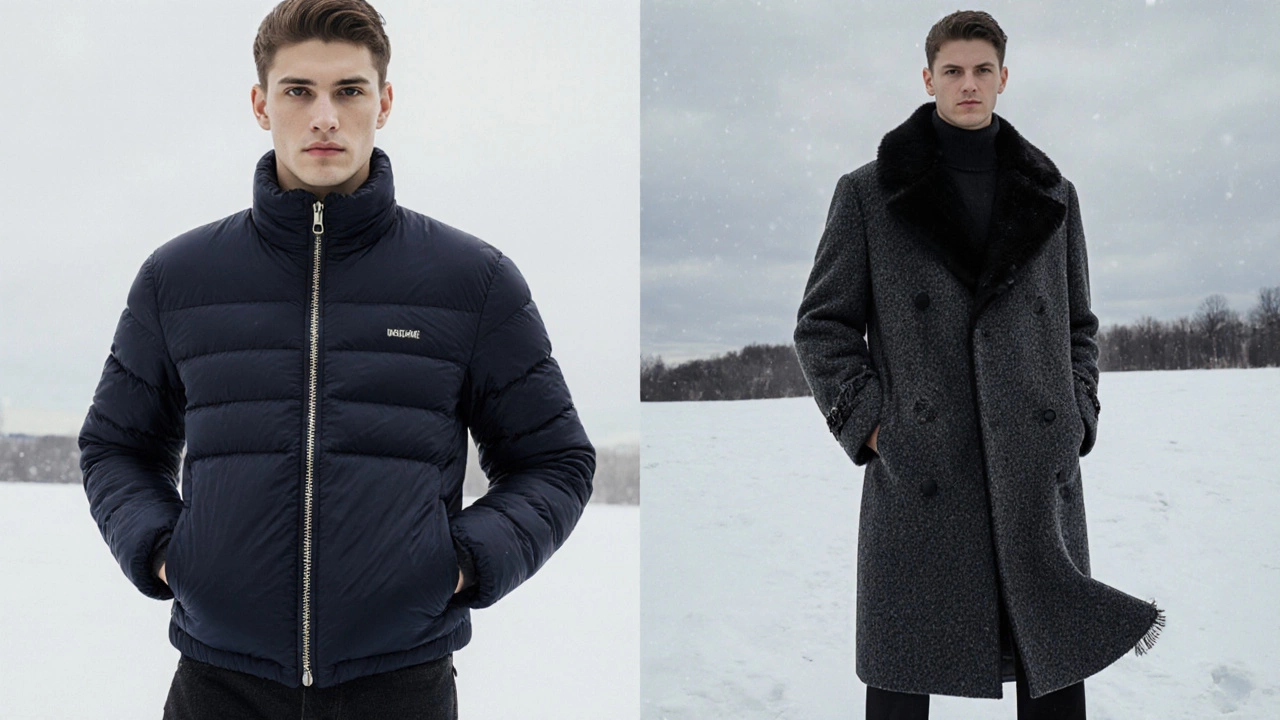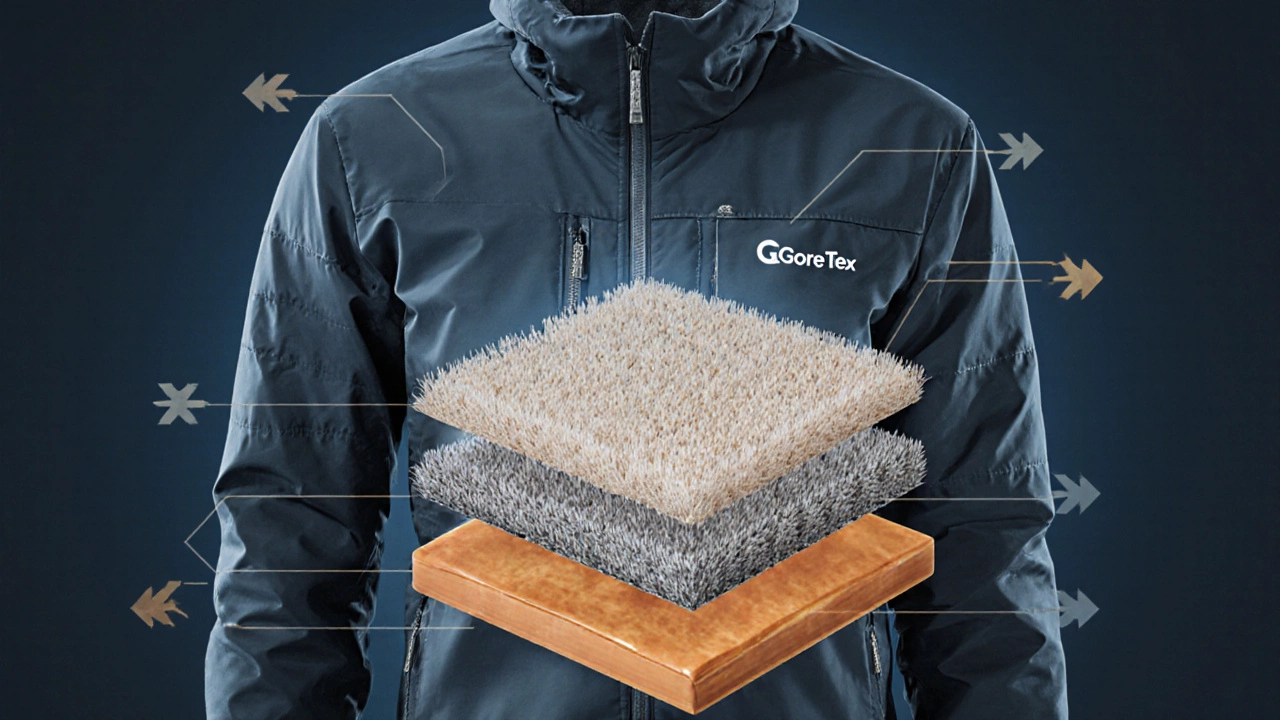Jacket vs Coat: Which Keeps You Warmer?

Temperature & Activity-Based Outerwear Calculator
Determine which outerwear type is best for your weather conditions and activity level. Based on the article's guidance about clo values and insulation requirements.
Enter your temperature and activity level to get personalized recommendations based on scientific warmth measurements.
Deciding whether a Jacket is warmer than a Coat feels like a simple question, but the answer depends on a handful of technical factors that most shoppers overlook. In this guide we break down the science of warmth, compare the key design elements, and give you a step‑by‑step way to pick the right piece for the weather you face.
Key Takeaways
- Length and coverage usually give coats a temperature advantage, but a high‑quality insulated jacket can beat a thin coat.
- Fill material (down, wool, synthetic) and its loft are bigger warmth drivers than the garment’s outer shell.
- Check the clo value or temperature rating to match the piece with your local climate.
- Activity level matters - a breathable jacket is better for high‑intensity outdoor sports, while a heavier coat suits low‑movement city wear.
- Consider care, cost, and style longevity before buying.
What Makes an Outerwear Piece Warm?
Warmth is a combination of trapped air, material conductivity, and how well the garment fits your body. Air is a poor conductor of heat, so any material that can hold a layer of still air next to your skin adds warmth. This is why fill materials like down or synthetic fibers are so effective - they create thousands of tiny pockets that trap heat.
The outer shell protects that insulated core from wind and moisture. Fabrics such as Gore‑Tex, polyester twill, or tightly woven wool act as a barrier, reducing convective heat loss. Inside the shell, a Lining often adds a soft, low‑friction surface that helps keep the insulation from shifting.
Manufacturers also assign a Clo value or temperature rating to each model. One clo is roughly the amount of insulation needed to keep a resting adult comfortable at 21 °C (70 °F) in a still room. Outdoor gear typically ranges from 0.3 clo (light windbreaker) up to 2.5 clo (heavy parkas).
Jacket vs Coat: Core Differences
A Jacket is a short‑to‑mid‑length outerwear piece, usually ending at the waist or hips. Jackets emphasize mobility and often feature lighter shells, slim cuts, and a focus on layering over the insulation.
In contrast, a Coat is designed for longer coverage, typically reaching the thighs or even the calves. Coats prioritize shelter from wind and precipitation, and they often incorporate heavier fill or thicker fabrics.
Because of these structural choices, a coat generally provides a higher baseline temperature protection, but the difference narrows when you compare a high‑tech insulated jacket with a lightweight summer coat.
Material Matters
Down is the gold standard for warmth‑to‑weight ratio. High‑fill‑power (FP) down, measured in cubic inches per ounce, can achieve loft values above 800 FP, meaning a small amount traps a lot of air. However, down loses its insulating ability when wet unless it’s treated with a hydrophobic coating.
Wool offers natural water resistance and breathability. Merino wool fibers create tiny air pockets while also absorbing moisture vapor, making wool coats comfortable in fluctuating temperatures.
Synthetic insulation such as Primaloft or Thinsulate mimics down’s loft but retains heat when damp. Modern synthetics can reach 600-700 FP and are lighter than wool, making them a solid choice for rainy climates.
The Shell fabric also influences warmth. A tightly woven polyester or nylon shell blocks wind, which can add up to 5 °F (≈3 °C) of effective warmth. Some shells include a waterproof membrane, further enhancing protection.

Length, Coverage, and Temperature Rating
Coverage is the simplest way to keep heat in. A coat that reaches the thighs reduces the amount of exposed skin and limits convective cooling. This extra length can translate to roughly a 0.2-0.3 clo boost compared with a waist‑length jacket.
Temperature rating charts help match garment to climate. For example:
- 0.3-0.5 clo - Suitable for 50-65 °F (10-18 °C) in light wind.
- 0.6-0.9 clo - Good for 30-50 °F (‑1-10 °C) with moderate wind.
- 1.0 clo and above - Ideal for sub‑30 °F (‑1 °C) conditions, especially when activity is low.
When you see a product description that lists “-20 °F rated,” it’s using a similar scale based on laboratory testing. Align that rating with your local winter averages to avoid over‑ or under‑buying.
Activity and Lifestyle Considerations
If you spend a lot of time moving-skiing, snowshoeing, or even brisk city walking-a jacket with high breathability and a flexible shell will keep you dry from sweat. Look for features like pit zips, mesh-lined cuffs, and a Lining that wicks moisture away.
For sedentary or commuting scenarios, a coat with a heavier fill and a longer hem provides consistent warmth without the need for rapid moisture management. Many urban coats also include a removable liner, giving you the option to adjust insulation as temperatures shift.
Another factor is layering. A thinner insulated jacket works well under a heavy sweater or fleece, while a coat might be enough on its own. Think about the typical number of layers you prefer before choosing.
Cost, Care, and Longevity
Price points vary widely. A basic polyester jacket can cost under $50, whereas a premium down parkas from heritage brands may exceed $500. Coats made from high‑quality wool or featuring proprietary synthetic fills also sit in the higher price range.
Maintenance affects long‑term value. Down jackets need special washing with low‑heat tumble drying and occasional re‑fluffing. Wool coats often require dry cleaning, adding ongoing costs. Synthetic‑filled garments are generally machine‑washable, making them more practical for everyday wear.
Durability hinges on construction quality: reinforced stitching, double‑stitched seams, and sturdy zippers extend a piece’s life. Investing in a well‑built coat can provide a decade of service, while a cheap jacket may need replacement after a few seasons.

Comparison Table: Jacket vs Coat
| Aspect | Jacket | Coat |
|---|---|---|
| Typical Length | Waist to hips | Mid‑thigh to calf |
| Average Clo Value | 0.3-0.9 clo | 0.8-2.5 clo |
| Common Fill Materials | Light down, synthetic fill, fleece | Heavy down, wool, synthetic |
| Best Use Cases | Active outdoor sports, layering in milder cold | Urban commuting, low‑activity cold days |
| Weight Range | 0.5-2 lb (0.2-0.9 kg) | 2-5 lb (0.9-2.3 kg) |
| Typical Price | $50-$250 | $150-$600 |
Quick Decision Checklist
- What is your usual temperature range? If you regularly face sub‑30 °F, lean toward a coat or a high‑clo jacket.
- How active are you while wearing the piece? For high activity, prioritize breathability and lighter fill.
- Do you need water resistance? Choose a shell with a waterproof membrane for snow or rain.
- What is your budget? Synthetic‑filled jackets give good warmth at lower cost; premium down coats justify higher spend for extreme cold.
- Are you ready for care requirements? Down needs special washing; wool may need dry cleaning.
Frequently Asked Questions
Is a jacket ever warmer than a coat?
Yes, if the jacket uses high‑fill‑power down or a thick synthetic insulation and the coat is a lightweight, unlined model, the jacket can provide more effective warmth.
How do I read a clo rating on a jacket?
A clo rating tells you how much insulation the garment offers. For everyday wear, aim for 0.5-0.7 clo; for extreme cold, look for 1.0 clo or higher.
Can I wear a coat in mild weather?
You can, but a heavy coat may cause overheating. Many coats come with removable liners, allowing you to adapt the piece to milder days.
What’s the best way to care for down insulation?
Use a front‑loading washing machine on a gentle cycle with down‑specific detergent. Tumble dry on low heat with clean tennis balls to restore loft.
Should I prioritize style over function?
Function comes first for warmth, but many brands now blend performance fabrics with fashionable cuts. Choose a piece that meets your climate needs and fits your wardrobe.
By weighing material, length, and intended use, you can decide whether a jacket vs coat will keep you comfortable this winter. The right choice isn’t about a single label-it’s about matching the technical specs to your daily life.
- Oct, 21 2025
- Violet Greenfield
- 0
- Permalink
Written by Violet Greenfield
View all posts by: Violet Greenfield